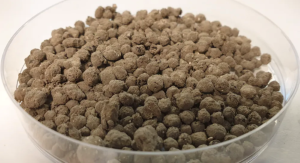In the wastewater that comes out of a household, human urine makes up just 1% of total volume. However, in terms of nutrients, urine contains more than 80% of the nitrogen and over half of the potassium and the phosphorus. In fact, urine produced by people worldwide contains enough nutrients to fertilise three-quarters of the food we eat.
Research on upgrading of toilet waste
Earlier this year, Dr. Prithvi Simha from the Department of Energy and Technology at SLU, defended his thesis, which developed a novel on-site sanitation technology called “alkaline urine dehydration” to capture all the nutrients in urine without its water. Prithvi and his team at SLU are working to disrupt the way we manage wastewater and design sanitation systems. They believe that resources like urine should be separately collected, safely treated to produce fertilisers, and returned to farmland to close the nutrient loop in our food system. If implemented globally, such a system could reduce the transgression of the planetary boundary for nitrogen and phosphorus by 35% and 25%, respectively.
 Some of the fertiliser produced by drying human urine. Photo: Prithvi Simha
Some of the fertiliser produced by drying human urine. Photo: Prithvi Simha
SLU Global asked Prithvi about the research:
How does the alkaline dehydration work?
– In fresh urine, collected as soon as it is excreted, nitrogen is mostly in the form of urea, the most widely used fertiliser in the world. But waste pipes in our homes are colonised by bacteria that produce an enzyme called urease, which rapidly degrades urea to ammonia, thereby producing hydrolysed urine and urine’s typical pungent smell. In alkaline dehydration, freshly collected urine is first made alkaline (high pH) to prevent it from breaking down to ammonia, after which urine is reduced into a dry powder by evaporating water. The result is a solid fertiliser containing 20% nitrogen, 2% phosphorus, 5% potassium and all the micronutrients that are naturally present in human urine.
What do you mean by an “on-site technology”?
– The technology, alkaline dehydration, works best when it is as close as possible to the source - at toilets and in buildings where urine is produced. We must remember that by composition, human urine is 95% water. So, today, if we want to recycle nutrients present in urine from urban areas to rural farmland, we also need to collect and transport this water. But if we treat and reduce the volume of urine at the source, we could simplify the logistics surrounding urine recycling. This means collecting and applying 30 kg of solid fertiliser per person instead of 550 liters of liquid urine.
How can the technique be implemented in low-income countries? Is it expensive?
– Drying is a simple operation that can be performed everywhere. An alkaline urine dryer can be put together in a few hours as it requires materials that are fairly easy to procure locally. By following a few simple steps, anyone can safely dry urine to produce a fertiliser. We have demonstrated that the technology works well in Sweden and Finland, but also in Bolivia where Dr. Luis Fernando Perez Mercado, an SLU alumnus, has been successfully running a household-scale urine dryer. To perform alkaline dehydration, households need to have electricity supply, as fans need to be operated for ventilation. Our current focus is on reducing the energy demand for evaporating water as this is important to ensure wider acceptance and suitability of the technology in different contexts.
Please explain how can it contribute to sustainable farming globally?
– The global system of food production is the largest human influence today on the planet’s natural cycles of nitrogen and phosphorus, since we add these two elements as artificial fertilisers on farmland. So, most of the food we eat today is not farmed sustainably. But we can change this by switching over to human urine-based fertilisers, which would reduce our negative impact on the planetary boundaries and have the added benefit of improving the sustainability of our sanitation system. Dehydrated urine, for instance, can be used in urban farming to improve the resilience of local food systems, transported and applied on rural cropland, or used as a raw material by the fertiliser industry.
Thank you Prithvi and have a nice World Toilet Day!

